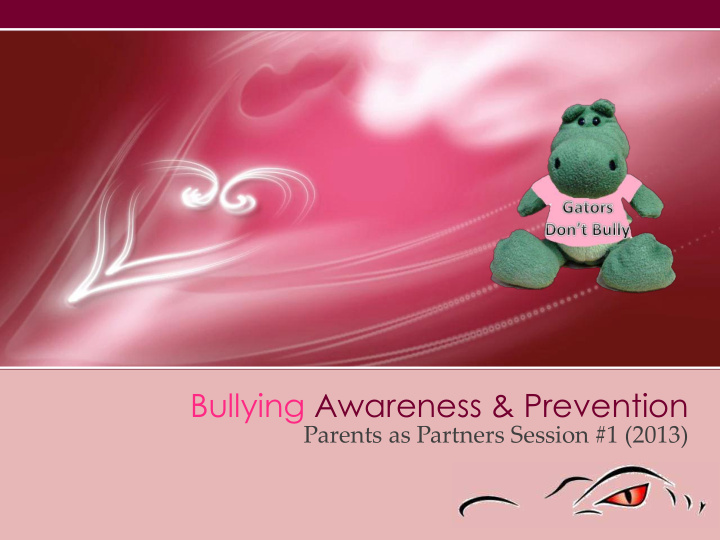



Bullying Awareness & Prevention Parents as Partners Session #1 (2013)
Parents as Partners - 2013 • 4 connected sessions this year! 1) Bullying Awareness & Prevention ( Feb. 27 th ) 2) Cyber-Awareness ( TBD ) 3) Building Resiliency: 40 Assets ( TBD ) 4) Anxiety/Depression/Mental Health ( TBD )
Goals for Tonight’s Session • Understand the differences between Conflict & Bullying • Recognize signs & strategies when it comes to your child and bullying • Provide a very basic introduction to cyber bullying
What our Students Have Been Learning… Primary & Intermediate Bullying Awareness Lessons - Learning a common language - Developing Skills - Encouraging Empathy - Gr 4s (Kids Are Great Program) - Lots and lots of student leadership opportunities! - A variety of programs to build students into empathetic and caring Gators
R E U L E F A S
Bullying vs. Conflict F R F E E N I C E
Conflict
Bullying
IMBALANCE of POWER? - Size - Age - Popularity - Personality (ex. aggressive vs. shy) - Intelligence - Wealth and Access…
SORTING ACTIVITY CONFLICT BULLYING
CONFLICT BULLYING
SIGNS
SIGNS of BEING BULLIED… - Afraid to go to school or other activities - Appear anxious or fearful - Low self-esteem and make negative comments - Complain of feeling unwell - Low interest - Lose things, need money, report being hungry - Injuries, bruising, damaged clothing or articles - Appear unhappy, irritable - Trouble sleeping, nightmares - Threats to hurt themselves or others - May appear isolated from the peer group
What can I look for then?
STRATEGIES
Proactive Strategies… - Encourage child to report - Ensure your child knows you won’t overreact - Model positive behaviour and look for those “teachable moments” - Be careful how you talk to or ask your child about bullying…
Asking the “Right” Questions… Make sure you have the time Avoid using the “B” word Use open-ended questions “What did you like the most about your day?” “What was the most frustrating part of your day?” Let your child do the talking “Tell me more about…”
Reactive Strategies… - Give yourself time to process your emotions (avoid overreacting) - Reassure, listen & respond caringly - Dig Deeper - Is it conflict or bullying? - Keep a record - Inform the school and make a plan together - Follow up on the plan with your child
Brief Introduction to Cyber-Bullying
What did that say??? Message Meaning TTYS Talk To You Soon PAW or PRW Parents Are Watching ROTFL Rolling on the Floor Laughing CYE Check Your Email LOL Laughing Out Loud ASL Age/Sex/Location BRB Be Right Back LMIRL Let’s Meet In Real Life
How is it Different? - Involves a whole new language - Can be far-reaching - Can take place 24/7 - Can be more cruel - Can look anonymous - Often involves a larger audience than we perceive - Is ever-changing!
Some Basics Strategies to Get You Started - Keep computers in a shared space - Limit use late at night - Learn about whatever your child does online - Know all passwords - Co-construct rules & expectations - Encourage open communication
Responding to Cyber-Bullying - Listen and be supportive - Communicate calmly with parents of cyber-bully (if known) - Save all evidence and logoff - Report the incident to school and/or authorities
Goals for Tonight’s Session • Understand the differences between Conflict & Bullying • Recognize signs & strategies when it comes to your child and bullying • Provide a very basic introduction to cyber bullying
Questions? More Information? Feedback Maeve Buckley maeve.buckley@sd23.bc.ca Leanne Kirschner leanne.kirschner@sd23.bc.ca Jordan Kleckner jordan.kleckner@sd23.bc.ca
Recommend
More recommend